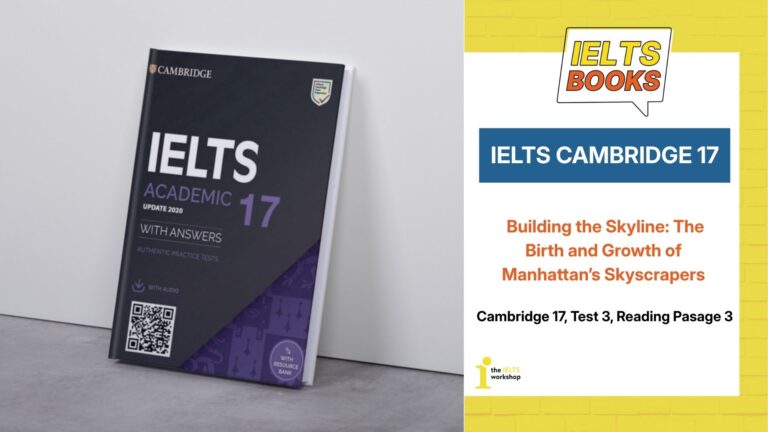Hy vọng rằng đáp án và phân tích chi tiết IELTS Cambridge 17 Test 3 Reading Passage 3: Building the Skyline: The Birth and Growth of Manhattan’s Skyscrapers từ The IELTS Workshop đã giúp bạn tự đánh giá chính xác trình độ hiện tại và rút ra được bài học hữu ích cho quá trình ôn tập. Đừng quên theo dõi thêm các nội dung học thuật và chiến lược luyện thi hiệu quả từ đội ngũ giảng viên chuyên môn cao của The IELTS Workshop, để hành trình chinh phục điểm số IELTS mong muốn trở nên dễ dàng và bài bản hơn mỗi ngày.
Đáp án IELTS Cambridge 17 Test 3 Reading Passage 3
| Câu hỏi | Đáp án |
| 27 | D |
| 28 | B |
| 29 | C |
| 30 | D |
| 31 | C |
| 32 | No |
| 33 | Yes |
| 34 | Not Given |
| 35 | No |
| 36 | H |
| 37 | D |
| 38 | I |
| 39 | B |
| 40 | F |
Phân tích chi tiết đáp án IELTS Cambridge 17 Test 3 Reading Passage 3
Câu 27: Đáp án D
Câu hỏi: What point does Shester make about Barr’s book in the first paragraph?
Dịch: Shester nói gì về cuốn sách của Barr trong đoạn đầu tiên?
Vị trí: Đoạn 1
Thông tin liên quan: Cuốn sách đề cập đến các yếu tố địa lý, lịch sử và kinh tế tác động đến sự phát triển của New York.
Phân tích:
- A và C không được đề cập.
- B không chính xác vì các nghiên cứu của Barr chỉ xuất hiện ở các chương sau.
- D là đúng vì sách bao quát nhiều yếu tố ảnh hưởng đến quá trình phát triển đô thị.
Câu 28: Đáp án B
Câu hỏi: How does Shester respond to the information in the book about tenements?
Dịch: Shester phản hồi thế nào với thông tin về các khu nhà ở?
Vị trí: Đoạn 3
Transcript: I would have liked Barr to expand upon his claim…
Phân tích: Việc Shester mong muốn tác giả làm rõ quan điểm chứng tỏ cô nghi ngờ hoặc thấy chưa thuyết phục ⇒ chọn B.
Câu 29: Đáp án C
Câu hỏi: What does Shester say about chapter six of the book?
Dịch: Shester nói gì về chương 6 của cuốn sách?
Vị trí: Đoạn 6
Transcript: It is probably more technical than would be preferred by a general audience.
Phân tích: ⇒ Quá kỹ thuật đối với người đọc thông thường ⇒ chọn C.
Câu 30: Đáp án D
Câu hỏi: What does Shester suggest about the chapters focusing on the 1920s building boom?
Dịch: Shester gợi ý gì về các chương viết về thời kỳ bùng nổ xây dựng năm 1920?
Vị trí: Đoạn 8
Transcript: Lengthy discussions of urban economic theory… serve as a distraction to readers primarily interested in New York.
Phân tích: Nội dung chương không phù hợp với tất cả đối tượng ⇒ D là chính xác.
Câu 31: Đáp án C
Câu hỏi: What impresses Shester the most about the chapter on land values?
Dịch: Điều gì khiến Shester ấn tượng nhất về chương nói về giá trị đất đai?
Vị trí: Đoạn 9
Transcript: Particularly impressive is Barr’s careful data analysis…
Phân tích: Shester ấn tượng bởi bản chất nghiên cứu và phân tích dữ liệu ⇒ chọn C.
Câu 32: Đáp án NO
Câu hỏi: The description in the first chapter of how New York probably looked from the air in the early 1600s lacks interest.
Dịch: Mô tả trong chương đầu tiên về New York những năm 1600 là không thú vị.
Vị trí: Đoạn 2
Transcript: A fascinating account of how the New York landscape in 1609 might have looked…
Phân tích: Ngược nghĩa với câu hỏi ⇒ Đáp án: NO.
Câu 33: Đáp án YES
Câu hỏi: Chapters two and three prepare the reader well for material yet to come.
Dịch: Chương 2 và 3 chuẩn bị người đọc tốt cho phần sau.
Vị trí: Đoạn 3
Transcript: Set the stage for the economic analysis that comes later…
Phân tích: Thông tin trùng khớp hoàn toàn ⇒ YES.
Câu 34: Đáp án NOT GIVEN
Câu hỏi: The biggest problem for many nineteenth-century New York immigrant neighbourhoods was a lack of amenities.
Dịch: Vấn đề lớn nhất với các khu nhập cư là thiếu tiện nghi.
Vị trí: Đoạn 4
Transcript: Analyzes their locations in terms of the amenities available…
Phân tích: Có nói đến tiện nghi, nhưng không đề cập vấn đề lớn nhất ⇒ NOT GIVEN.
Câu 35: Đáp án NO
Câu hỏi: In the nineteenth century, New York’s immigrant neighbourhoods tended to concentrate around the harbour.
Dịch: Các khu nhập cư thường tập trung quanh cảng.
Vị trí: Đoạn 4
Transcript: Between the industries on the waterfront and wealthy neighborhoods near Central Park.
Phân tích: Nằm giữa, không phải tập trung quanh cảng ⇒ NO.
Questions 36–40: Summary Completion
Câu 36: Đáp án H – specific areas
Vị trí: Đoạn 7
Transcript: Absence of bedrock … reason for skyscrapers not being built between the two urban centers.
Phân tích: Khu vực giữa Midtown và Downtown ⇒ specific areas.
Câu 37: Đáp án D – excessive expense
Transcript: Foundation costs were neither prohibitively high…
Phân tích: Chi phí không quá cao ⇒ loại trừ “excessive expense”.
Câu 38: Đáp án I – total expenditure
Transcript: Compared to the overall cost of building a skyscraper.
Phân tích: Chi phí móng không đáng kể so với tổng chi phí ⇒ chọn I.
Câu 39: Đáp án B – deep excavations
Transcript: Use of caissons … enable workers to dig down for considerable distances.
Phân tích: Cho phép đào sâu ⇒ deep excavations.
Câu 40: Đáp án F – associated risks
Transcript: Discusses not only how caissons work but also the dangers involved.
Phân tích: Dangers = associated risks ⇒ chọn F.
Phân tích chi tiết IELTS Cambridge 17 Test 3 Reading Passage 3
Katharine L. Shester reviews a book by Jason Barr about the development of New York City
Katharine L. Shester viết bài đánh giá về một cuốn sách của tác giả Jason Barr xoay quanh quá trình phát triển của thành phố New York.
1.
In Building the Skyline, Jason Barr takes the reader through a detailed history of New York City. The book combines geology, history, economics, and a lot of data to explain why business clusters developed where they did and how the early decisions of workers and firms shaped the skyline we see today. Building the Skyline is organized into two distinct parts. The first is primarily historical and addresses New York’s settlement and growth from 1609 to 1900; the second deals primarily with the 20th century and is a compilation of chapters commenting on different aspects of New York’s urban development. The tone and organization of the book changes somewhat between the first and second parts, as the latter chapters incorporate aspects of Barr’s related research papers.
Trong cuốn Building the Skyline, Jason Barr dẫn dắt người đọc khám phá một cách tỉ mỉ lịch sử hình thành của thành phố New York. Cuốn sách kết hợp giữa địa chất học, lịch sử, kinh tế học và một khối lượng lớn dữ liệu nhằm giải thích tại sao các cụm doanh nghiệp lại hình thành tại những địa điểm cụ thể, đồng thời chỉ ra cách mà những quyết định ban đầu của người lao động và các công ty đã góp phần định hình nên đường chân trời của thành phố hiện nay. Sách được chia làm hai phần rõ rệt: phần đầu chủ yếu nói về lịch sử từ năm 1609 đến 1900, còn phần hai tập trung vào thế kỷ 20, gồm nhiều chương bàn luận về các khía cạnh khác nhau trong quá trình đô thị hóa của New York. Giọng văn và cấu trúc của sách cũng thay đổi giữa hai phần, do các chương sau mang nhiều nét của các nghiên cứu học thuật từ Barr.
Từ vựng cần nhớ:
- cluster (n) /ˈklʌstə(r)/: cụm, khu vực
- skyline (n): đường chân trời (của thành phố)
- geology (n): địa chất học
- urban development (n): phát triển đô thị
2.
Barr begins chapter one by taking the reader on a ‘helicopter time-machine’ ride—giving a fascinating account of how the New York landscape in 1609 might have looked from the sky. He then moves on to a subterranean walking tour of the city, indicating the location of rock and water below the subsoil, before taking the reader back to the surface. His love of the city comes through as he describes various fun facts about the location of the New York residence of early 19th-century vice-president Aaron Burr as well as a number of legends about the city.
Barr bắt đầu chương đầu tiên với một hình ảnh hấp dẫn – ông đưa người đọc “lên máy bay trực thăng xuyên thời gian”, để mô phỏng cảnh quan của New York năm 1609 nhìn từ trên cao sẽ như thế nào. Sau đó, ông dẫn dắt độc giả đi xuống dưới lòng đất, chỉ ra các vị trí có đá và nước ngầm bên dưới lớp đất nền, rồi đưa mọi người trở lại mặt đất. Tình cảm của ông dành cho thành phố thể hiện rõ qua những chi tiết thú vị về nơi ở của phó tổng thống Aaron Burr vào đầu thế kỷ 19, cùng với nhiều truyền thuyết gắn liền với thành phố này.
Từ vựng cần nhớ:
- subterranean (adj) /ˌsʌbtəˈreɪniən/: dưới lòng đất
- account (n): mô tả, câu chuyện
- residence (n): nơi cư trú
3.
Chapters two and three take the reader up to the Civil War (1861–1865), with chapter two focusing on the early development of land and the implementation of a grid system in 1811. Chapter three focuses on land use before the Civil War. Both chapters are informative and well researched and set the stage for the economic analysis that comes later in the book. I would have liked Barr to expand upon his claim that existing tenements prevented skyscrapers in certain neighborhoods because ‘likely no skyscraper developer was interested in performing the necessary “slum clearance”. Later in the book, Barr makes the claim that the depth of bedrock was not a limiting factor for developers, as foundation costs were a small fraction of the cost of development. At first glance, it is not obvious why slum clearance would be limiting, while more expensive foundations would not.
Hai chương tiếp theo đưa người đọc đến giai đoạn Nội chiến Hoa Kỳ (1861–1865). Chương hai tập trung vào quá trình phát triển đất đai ban đầu và việc áp dụng hệ thống đường lưới vào năm 1811, còn chương ba đề cập đến cách sử dụng đất trước thời kỳ nội chiến. Cả hai chương đều rất nhiều thông tin và được nghiên cứu kỹ lưỡng, tạo tiền đề cho các phân tích kinh tế ở phần sau của sách. Tác giả có đề cập rằng việc tồn tại các khu nhà tồi tàn đã cản trở việc xây dựng các tòa nhà chọc trời, do các nhà phát triển không muốn thực hiện công tác “giải tỏa khu ổ chuột”. Về sau, ông cũng nhấn mạnh rằng độ sâu của lớp đá móng không phải là rào cản lớn, vì chi phí nền móng chỉ chiếm phần nhỏ trong tổng chi phí xây dựng. Thoạt nhìn, điều này gây khó hiểu vì rõ ràng việc dọn dẹp khu ổ chuột nghe có vẻ ít tốn kém hơn việc đào nền móng sâu.
Từ vựng cần nhớ:
- tenement (n): nhà tập thể, nhà ổ chuột
- slum clearance (n): giải tỏa khu ổ chuột
- foundation (n): nền móng
- bedrock (n): lớp đá nền
4.
In chapter four, Barr moves into the twentieth century. He explores geographic differences in the height of skyscrapers and uses data to investigate whether bedrock depth or other factors were more important. He finds that bedrock depth was not a significant determinant of building height, as there are many tall buildings where the bedrock is deep and many short buildings where the bedrock is shallow. Instead, he finds that the variation in building height is best explained by looking at economic factors such as the value of the land and the income that could be earned from tenants.
Sang chương bốn, Barr bước vào thế kỷ 20 và bắt đầu phân tích sự khác biệt về độ cao các tòa nhà chọc trời tại những khu vực khác nhau. Ông sử dụng dữ liệu để kiểm tra xem độ sâu của lớp đá móng hay yếu tố nào khác đóng vai trò quan trọng hơn. Kết luận của ông là: độ sâu của đá móng không phải là yếu tố quyết định chiều cao của công trình. Bằng chứng là có nhiều tòa nhà cao được xây trên nền đá sâu và ngược lại. Thay vào đó, yếu tố kinh tế như giá trị của mảnh đất và thu nhập tiềm năng từ người thuê mới là những yếu tố lý giải tốt nhất sự khác biệt về độ cao.
Từ vựng cần nhớ:
- determinant (n): yếu tố quyết định
- tenant (n): người thuê (nhà, văn phòng)
- variation (n): sự khác biệt, biến đổi
5.
Chapters five and six examine the “Roaring Twenties” and the building boom that occurred during that time. These chapters document changes in the Manhattan skyline as well as the economic and technological changes that made these developments possible. Barr combines data from tax assessments, digitized land maps, and prior research to measure the number of skyscrapers built and their heights across different areas of the city. He concludes that skyscraper heights were primarily determined by economic demand rather than geology.
Chương năm và sáu tập trung vào “Thập niên 20 sôi động” – thời kỳ bùng nổ xây dựng của thành phố. Tác giả ghi nhận sự thay đổi đáng kể của đường chân trời Manhattan trong giai đoạn này, đồng thời giải thích các yếu tố kinh tế và công nghệ đã góp phần thúc đẩy sự phát triển mạnh mẽ đó. Ông tổng hợp dữ liệu từ đánh giá thuế, bản đồ đất đai số hóa và các nghiên cứu trước đó để đo lường số lượng và chiều cao của các tòa nhà chọc trời trên từng khu vực trong thành phố. Kết luận được đưa ra là: chính nhu cầu kinh tế, chứ không phải yếu tố địa chất, mới là nguyên nhân chính quyết định chiều cao của các công trình.
Từ vựng cần nhớ:
- building boom (n): sự bùng nổ xây dựng
- digitized (adj): được số hóa
- tax assessment (n): đánh giá thuế
6.
Chapter seven presents the argument that skyscrapers are ‘natural phenomena’ in big cities. Barr uses a simple theoretical model and data on building size and height to demonstrate that developers build tall to economize on land costs. However, the taller the building, the more expensive it is to build each additional floor. He extends this analysis using a simulation model to predict how high buildings would be in various parts of New York if land values rose.
Chương bảy đưa ra một quan điểm thú vị: các tòa nhà chọc trời là một “hiện tượng tự nhiên” ở các đô thị lớn. Barr sử dụng một mô hình lý thuyết đơn giản kết hợp với dữ liệu về diện tích và chiều cao công trình để cho thấy rằng các nhà phát triển xây cao nhằm tiết kiệm chi phí đất. Tuy nhiên, xây càng cao thì chi phí cho mỗi tầng bổ sung lại càng đắt đỏ. Ông còn phát triển mô hình này bằng cách mô phỏng để dự đoán chiều cao các tòa nhà trong những khu vực khác nhau của New York nếu giá đất tiếp tục tăng.
Từ vựng cần nhớ:
- phenomenon (n): hiện tượng
- economize (v): tiết kiệm chi phí
- simulation model (n): mô hình mô phỏng
7.
In the final chapter, Barr summarizes the key findings and reflects on the importance of understanding urban development. He emphasizes that while geological factors may have played a role, it is the economic and social choices that shaped the skyline of Manhattan. Barr ends by noting that cities are not just products of physical geography but also of human decisions, making urban economics a vital field for future research.
Ở chương cuối, Barr tổng kết các phát hiện chính trong cuốn sách và nhấn mạnh tầm quan trọng của việc hiểu về sự phát triển đô thị. Ông khẳng định rằng, mặc dù yếu tố địa chất có thể có ảnh hưởng, nhưng chính các quyết định kinh tế và xã hội mới thực sự định hình nên đường chân trời Manhattan. Ông kết luận rằng thành phố không chỉ là sản phẩm của địa lý tự nhiên, mà còn là kết quả của các lựa chọn của con người – điều này khiến kinh tế học đô thị trở thành một lĩnh vực nghiên cứu thiết yếu trong tương lai.
Từ vựng cần nhớ:
- reflect on (v): suy ngẫm về
- urban economics (n): kinh tế học đô thị
- vital (adj): thiết yếu
8.
Overall, Building the Skyline is an interesting read. The book is successful in explaining the economics behind the location of skyscrapers. The historical chapters are rich in detail and explore fascinating aspects of New York City’s past. The later chapters provide solid economic analysis and are accessible to a broad audience. However, the shift in tone and approach between the historical and economic parts of the book may be slightly jarring to some readers. Still, the combination of storytelling and analysis makes it a valuable contribution to the field of urban studies.
Tổng thể, Building the Skyline là một cuốn sách đáng đọc. Tác phẩm đã thành công trong việc lý giải các yếu tố kinh tế đứng sau sự hình thành vị trí của các tòa nhà chọc trời. Phần đầu của sách mang đậm tính lịch sử, được trình bày chi tiết và hé lộ nhiều khía cạnh thú vị về quá khứ của thành phố New York. Các chương sau đó cung cấp phân tích kinh tế rõ ràng, dễ tiếp cận với nhiều đối tượng độc giả. Tuy nhiên, sự thay đổi về giọng văn và cách tiếp cận giữa phần lịch sử và phần phân tích kinh tế có thể khiến một số người cảm thấy hơi đột ngột. Dù vậy, sự kết hợp giữa kể chuyện và phân tích giúp cuốn sách trở thành một đóng góp giá trị cho lĩnh vực nghiên cứu đô thị.
Từ vựng cần nhớ:
- accessible (adj): dễ tiếp cận, dễ hiểu
- shift in tone (n): sự thay đổi trong giọng văn
- urban studies (n): nghiên cứu đô thị
- valuable contribution (n): đóng góp giá trị
9.
Barr’s work is at its best when he blends historical narrative with economic insight. His discussions on the economic motivations behind urban development are particularly strong, and his ability to bring together so many different sources of data is impressive. For example, his use of digitized historical maps and tax records shows his commitment to understanding the city’s evolution in a rigorous way. The book will appeal to readers interested in history, economics, and urban planning, although those seeking a traditional chronological account may find the structure a little unusual.
Tác phẩm của Barr trở nên xuất sắc nhất khi ông kết hợp giữa tường thuật lịch sử và phân tích kinh tế sâu sắc. Những lập luận của ông về động cơ kinh tế đứng sau quá trình phát triển đô thị đặc biệt thuyết phục, và khả năng tổng hợp nhiều nguồn dữ liệu khác nhau thực sự ấn tượng. Chẳng hạn, việc ông sử dụng bản đồ lịch sử số hóa và hồ sơ thuế chứng tỏ nỗ lực nghiêm túc trong việc hiểu rõ sự phát triển của thành phố qua thời gian. Cuốn sách này sẽ hấp dẫn với những độc giả quan tâm đến lịch sử, kinh tế và quy hoạch đô thị – dù với những ai ưa thích cách kể chuyện theo trình tự thời gian truyền thống có thể thấy cấu trúc sách hơi lạ lẫm.
Từ vựng cần nhớ:
- narrative (n): câu chuyện, bài tường thuật
- economic insight (n): góc nhìn kinh tế
- rigorous (adj): nghiêm ngặt, kỹ lưỡng
- chronological (adj): theo trình tự thời gian
10.
Finally, what makes Building the Skyline stand out is its ambitious scope. Barr does not limit himself to one discipline; instead, he draws on geology, history, economics, and urban planning to tell a comprehensive story. The result is a book that not only explains why the Manhattan skyline looks the way it does today, but also provides a model for how to study cities more generally. It is a reminder that cities are complex systems shaped by a variety of forces, and understanding them requires an equally multifaceted approach.
Cuối cùng, điều khiến Building the Skyline nổi bật chính là phạm vi nghiên cứu đầy tham vọng của nó. Barr không giới hạn bản thân trong một lĩnh vực cụ thể, mà kết hợp cả địa chất học, lịch sử, kinh tế học và quy hoạch đô thị để kể nên một câu chuyện toàn diện. Kết quả là một cuốn sách không chỉ giải thích vì sao đường chân trời Manhattan lại có hình dạng như hiện nay, mà còn đưa ra một mô hình lý tưởng để nghiên cứu về các thành phố nói chung. Cuốn sách như một lời nhắc nhở rằng: thành phố là những hệ thống phức tạp, được hình thành bởi nhiều yếu tố khác nhau, và để hiểu rõ chúng, chúng ta cần một cách tiếp cận đa chiều.
Từ vựng cần nhớ:
- ambitious scope (n): phạm vi nghiên cứu đầy tham vọng
- multifaceted (adj): đa chiều, nhiều mặt
- discipline (n): lĩnh vực nghiên cứu
- comprehensive (adj): toàn diện
Series giải đề IELTS Cambridge 17
- [PDF + Audio] Cambridge IELTS 17 – Cambridge Practice Tests For IELTS 17 With Answers
- Đáp án Cambridge 17 & lời giải chi tiết: Test 1 – Test 4
- IELTS Cambridge 17, Test 3, Listening Part 1: Advice on surfing holidays.
- IELTS Cambridge 17, Test 3, Listening Part 2: Childcare service.
- IELTS Cambridge 17, Test 3, Listening Part 3: Holly’s Work Placement Tutorial.
- IELTS Cambridge 17, Test 3, Listening Part 4: Bird Migration Theory.
- Giải chi tiết Cambridge 17 Reading Test 3:
- IELTS Cambridge 17, Test 3, Reading Passage 1: The thylacine.
- IELTS Cambridge 17, Test 3, Reading Passage 2: Palm oil.
- IELTS Cambridge 17, Test 3, Reading Passage 3: Building the Skyline: The Birth and Growth of Manhattan’s Skyscrapers.
- [PDF + Audio] Trọn bộ Cambridge Practice Tests For IELTS 1 – 20 mới nhất
Bạn có thể tham gia khóa HỌC IELTS MIỄN PHÍ cùng các giáo viên 9.0 tại Website The IELTS Workshop để nắm vững phương pháp học cũng như các kỹ năng làm bài thi IELTS từ thầy cô nhé!



![[PDF + Audio] Trọn bộ Cambridge Practice Tests For IELTS 1 – 20 mới nhất](https://onthiielts.com.vn/wp-content/uploads/2020/04/cam-1-14-764x400.jpg)
![[PDF + Audio] Cambridge IELTS 20: Cập nhật mới nhất (Bản đẹp)](https://onthiielts.com.vn/wp-content/uploads/2025/07/Cambridge-IELTS-20-300x169.jpg)




